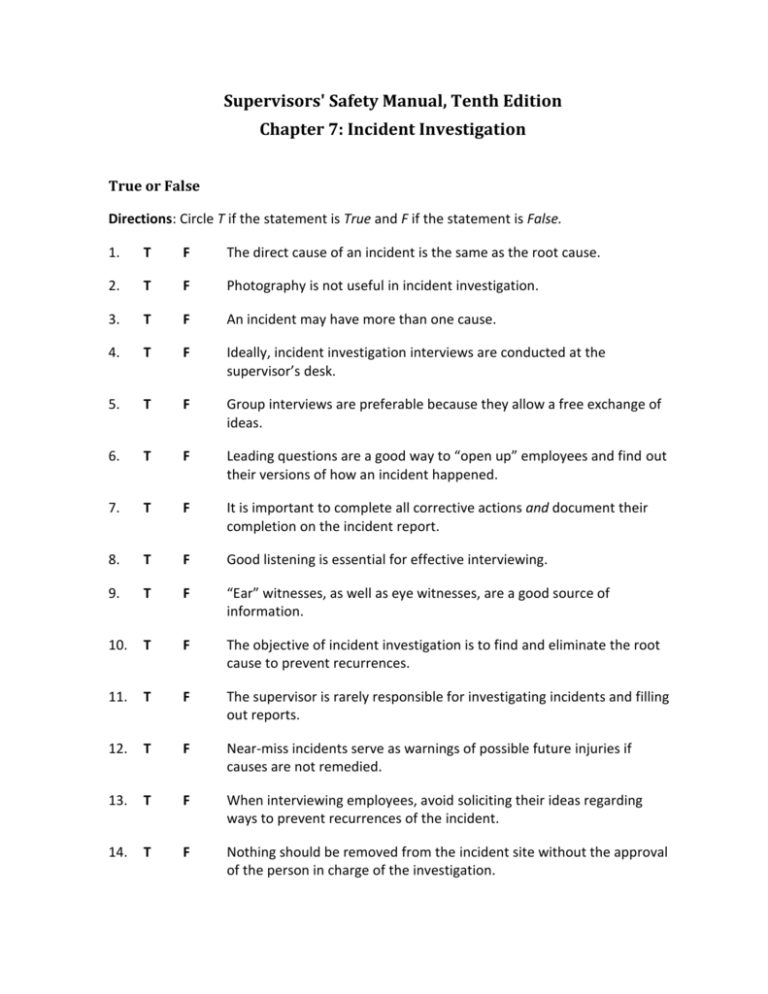SSDP Module 7, Incident Investigation
advertisement

Supervisors' Safety Manual, Tenth Edition Chapter 7: Incident Investigation True or False Directions: Circle T if the statement is True and F if the statement is False. 1. T F The direct cause of an incident is the same as the root cause. 2. T F Photography is not useful in incident investigation. 3. T F An incident may have more than one cause. 4. T F Ideally, incident investigation interviews are conducted at the supervisor’s desk. 5. T F Group interviews are preferable because they allow a free exchange of ideas. 6. T F Leading questions are a good way to “open up” employees and find out their versions of how an incident happened. 7. T F It is important to complete all corrective actions and document their completion on the incident report. 8. T F Good listening is essential for effective interviewing. 9. T F “Ear” witnesses, as well as eye witnesses, are a good source of information. 10. T F The objective of incident investigation is to find and eliminate the root cause to prevent recurrences. 11. T F The supervisor is rarely responsible for investigating incidents and filling out reports. 12. T F Near-miss incidents serve as warnings of possible future injuries if causes are not remedied. 13. T F When interviewing employees, avoid soliciting their ideas regarding ways to prevent recurrences of the incident. 14. T F Nothing should be removed from the incident site without the approval of the person in charge of the investigation. 15. T F Corrective actions are generally not part of the incident investigation report. Multiple Choice Directions: Select the best answer and place the corresponding letter in the box provided. 16. 1 The types of incidents that should be reported and investigated include: A. Injuries B. Property damage. C. Near-miss incidents. D. All of the above. 17. 1 The primary purpose of incident investigation is: A. Statistical analysis. B. To assign fault. C. To prevent recurrence. D. All of the above. 18. 1 Incidents usually have: A. Two direct causes. B. One indirect cause. C. An underlying root cause. D. Supervisory error as a cause. 19. 1 Interviews are best conducted: A. In private. B. One at a time. C. As soon as possible after the incident. D. All of the above. 20. 1 A very important feature of effective incident investigation is: A. Completing the corrective actions to prevent future injuries. B. Asking leading questions. C. Assigning fault. D. Conducting a site safety audit. 21. 1 Interviews should end by: A. Warning witnesses not to talk to anybody else. B. Thanking witnesses for their time and cooperation. C. Referring those involved in the incident for disciplinary action. D. All of the above. 22. 1 An incident report may include: A. The sequence of events leading up to the incident. B. What the employee was doing at the time of the incident. C. Whether the employee was supervised at the time of the incident. D. All of the above. 23. 1 An example of an open-ended question is: A. Where was he standing? B. Was he standing over there? C. Don’t you think he was standing right here? D. All of the above. 24. 1 It is important to report near-miss incidents because: A. They generate a lot of paperwork. B. They have the potential to become serious incidents. C. The incidence rate computation must be accurate. D. All of the above. 25. 1 Which of the following is NOT one of the seven steps for incident investigation? A. Securing the incident site. B. Determination of disciplinary/punitive action. C. Identifying witnesses. D. Preserving evidence. Chapter 7: Incident Investigation Answer Key 1. 2. 3. 4. 5. 6. 7. 8. 9. 10. 11. 12. 13. 14. 15. 16. 17. 18. 19. 20. 21. 22. 23. 24. 25. F F T F F F T T T T F T F T F D C C D A B D A B B








